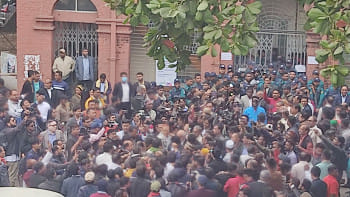ONLY QUALITY CABLE CAN ENSURE SAFE GROWTH

The cable industry in Bangladesh is growing rapidly. Earlier most of the cables were imported. But now the situation has changed; the local cable industries meet most of the cable demand.
KM Ali, CEO of Partex Star Group, informs that the current growth in the cable industry is around 15 percent. He anticipates that the growth will be higher in the future since the demand of electricity is growing exponentially in rural areas and the government is promoting industrialisation beyond Dhaka and Chittagong.
AKM Ahasanul Haque, Chief Operating Officer of Partex Cables Limited, says that the government has a plan to generate 40,000MW of power by 2030. To achieve that goal huge expansion in the power distribution sector is required. The government is already carrying out upgradation of transmission line from 132kV to 400kV. The present capacity of local cable industries is 132kV overhead conductors. Some companies are also manufacturing 220kV overhead conductors. Mr Haque thinks that there is a scope for expansion of local cable industries in the production of transmission cables.
He adds that underground cable is another potential growth area. The government is planning to lay underground cables in the city areas to reduce risk and save space which will generate high demand for 11kV and 33kV underground power cables.
He claims that local industries are capable of manufacturing these cables and the government should assess the capacity of local producers. If they are capable of producing sophisticated cables then the government should prioritise them over foreign companies. The government can impose some duty barriers to discourage import of cables which the local industries are able to produce. This will create employment and save foreign currency, he suggests.
Mr Haque also urges the government to rethink the policy requiring a minimum of five years' manufacturing experience. He believes that the government should instead focus on expertise of the industry. If a company has all the necessary capacities it should not be kept waiting for five years. According to him, this will only discourage new entrepreneurs in the cable industry.
On the quality issue of cable products, KM Ali reveals that except a few industries most of the local cable companies are not following the standard manufacturing process. Some companies are offering high discounts compromising quality of the products. Hence the cable market is suffering from unfair competition. He says that there are certain standards set by the International Electrotechnical Commission that should be followed during production of cables.
There are two basic elements of a cable: conductor and insulation. Quality conductors ensure better electricity flow, and quality insulation reduces voltage drops. The purity of conductor materials—copper or aluminium—determines conductivity. Therefore sourcing of raw materials for conductors is a key component of ensuring quality of a cable product, explains Ahasanul Haque.

Commonly used insulation materials are PVC, XLPE and rubber. Although PVC is easily bendable it is not suitable for higher temperatures. XLPE insulation is better suited for this purpose. In Bangladesh we still see use of PVC insulation in high tension cables. Since high tension cables carry high voltage they require very high insulation resistance for which XLPE is the safest option, states Mr Haque. He also suggests increased use of aluminium in power cables as a cost-effective solution.
He further adds that many companies claim that their cables are fireproof which is not true. Every metal melts at a certain temperature. The most important thing to consider here is how long the conductors conductivity and signal remains uninterrupted during fire. He recommends that use of flame-retardant and fire resistant cables be promoted to prevent short-circuit-related fire incidents.

KM Ali observes that although various regulatory bodies and organisations highlight the importance of fire safety in buildings, they do not put adequate emphasis on the use of fire-retardant cables. Cable is the most sensitive element among building materials but it gets the least attention from building owners as well as regulators. Mr Ali urges the government to specify the quality of cables to be used in various types of buildings in the Bangladesh National Building Code.
Ahasanul Haque adds that a large portion of electricity is being lost during the transmission process due to poor quality of cables. If the government enforces use of quality cables it will significantly reduce system loss.
He also emphasises making people aware about using quality cables in buildings. The owner of a building should know that the cost of cables comprises a very small percentage of the total cost of the building. But faulty cables can damage the whole structure. Both the government and cable industries should join hands in educating general users. Cable is too sensitive a product to be left to technicians who have very little knowledge about the quality of a cable product, concludes Mr Haque.

 For all latest news, follow The Daily Star's Google News channel.
For all latest news, follow The Daily Star's Google News channel. 



Comments